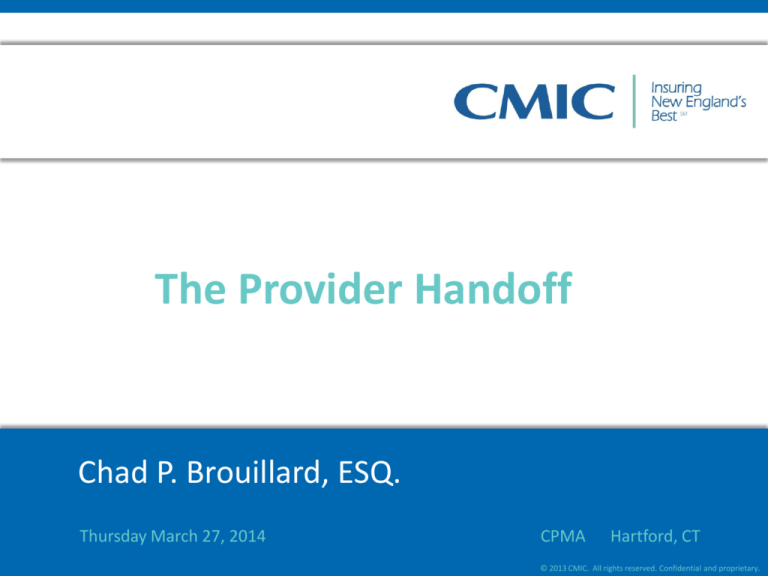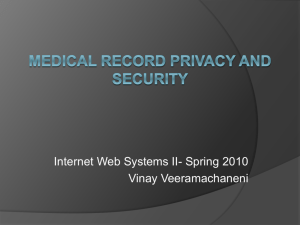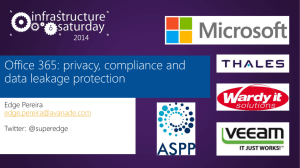
The Provider Handoff
Chad P. Brouillard, ESQ.
Thursday March 27, 2014
CPMA
Hartford, CT
© 2013 CMIC. All rights reserved. Confidential and proprietary.
DISCLOSURE STATEMENT
Chad Brouillard, Esq. has no financial
relationships to disclose
Chad Brouillard, Esq. is with Foster & Eldridge,
LLP in Cambridge, MA.
Objectives
• Recognize prevalent issues with EMR
management which have resulted in medical
malpractice losses
• Understand legal ramifications of not using
technology responsibly and effectively (case
examples)
• Discuss best practices for minimizing risk while
using electronic health records
EHR- The Essentials
• EHR - comprehensive computerized healthcare records in enterprise-wide systems
• EMR – same thing, except smaller scope
• EHR and EMR have been used interchangeably
for years despite technical differences
EHR- The Essentials
• There are many different types of EHR
– Homegrown
– Purchased
– Custom made
– Hybrid paper/electronic
– Multi department record systems
700+ Vendors, over 6000 certified implementations.
New York Times
March 11, 2009
“Wal-Mart Plans to Market Digital Health
Records System”
Wal-Mart Stores is striding into the market for
electronic health records, seeking to bring the
technology into the mainstream for physicians
in small offices, where most of America’s
doctors practice medicine.
Overview
• The delivery of health care, whether in a
hospital or a physician office, is a complex
process that involves a large number of
people. The importance of communication
methods that provide accurate, timely and
available information is underscored by the
fact that communication failures have been
identified in 80% of medical malpractice cases.
BENEFITS OF EHR
• ↑ Quality of care;
• ↑ Patient Safety;
• ↑ Operational efficiency;
• ↑ Bottom-line financial results.
Devil is in the details
How are electronic records changing the
landscape of
medical malpractice cases?
Discovery
• The process of discovery is the opportunity of
litigants to uncover every stone. There are
several different discovery vehicles:
• Written questions (Ints & RFA);
• Oral questions (Depositions);
• Production of “documents”.
eDiscovery
• With the implementation of EHR, eDiscovery
adds a whole new element to traditional
discovery.
• eDiscovery refers to the rules governing the
disclosure of electronic data, or ESI, contained
within any possible electronic medium.
eDiscovery UPDATE
• The Supreme Judicial Court of Massachusetts
has enacted formal eDiscovery rules into the
laws governing civil cases.
• In effect as of January 1, 2014.
• Provides an effective vehicle for plaintiff’s
attorney to seek electronic data in and outside
your EHR.
• Imposes obligations on owners of information
systems such as EHRs.
eDiscovery
• What could be subject to eDiscovery:
•Office computer;
•Personal computers;
•Smart phones;
•Email;
•Texts;
•Websites;
•Interactive patient sites.
eDiscovery
• How is a the storage of information in a EMR
different from a Paper Chart?
• Remember the good old days:
– The chart;
– The office schedule;
– A phone message record book;
– The billing record;
– If it didn’t exist, than don’t create it! (Memory and
custom and practice prevailed!)
eDiscovery
• With eDiscovery, the printed EHR is
just the beginning….
eDiscovery
•
•
•
•
•
•
Audit Trails;
Metadata;
Data Exchanges;
Clinical decision support (Clinical pathways);
Pharmacy/Prescribing;
Remaining paper sources (i.e. handwritten
sheets in radiology folders, writing on fetal
monitoring strips.) (Can contradict EHR)
Discovery
• In a legal case, what is the Plaintiff’s Attorney
looking for….
eDiscovery
• With eDiscovery the Smoking Gun very well
may be invisible to the naked eye.
• Metadata;
• Audit trails.
Metadata/Audit Trail
• The metadata and audit trails can include
details about:
– WHO created the record;
– WHEN the record was created;
– Whether the record was CHANGED;
– WHEN the record was changed;
– WHO accessed the record;
– WHEN the record was accessed.
Metadata/Audit Trail
• Why is the Audit trail important to you?
• Can be utilized to call your competence or
credibility into question.
OR
• Can be used to demonstrate timely and
responsible record keeping and eliminate the
specter of impropriety.
Search for the smoking gun
• Example 1:
A young patient of a PCP commits suicide. A
malpractice suit is filed against the PCP. The
claim is negligence. At the discovery stage,
the plaintiff’s attorney requests the EMR and
all audit trails. The plaintiff’s attorney tells us,
she thinks the PCP altered her record. The
doctor denies the allegation.
• What did the audit trail reveal?
The Audit Trail- Timing of the Note
• It revealed that the PCP created her note two
months after the patient’s suicide.
• Doctor speculated that someone else in the
office could have accessed her note after its
creation and accidentally altered the date.
• Metadata revealed she was the only provider
to access the chart.
The Audit Trail- Timing of the Note
Without even reading the note content, how will
the audit trail hurt the PCP?
The Audit Trail- Timing of the Note
• The physician is cast as:
– Not conscientious or not diligent;
– Uncaring;
– Lazy;
– Too busy;
– Guilty;
– Unbelievable.
Smoking Gun
• As to the content of the note itself, plaintiff’s
counsel will attack its reliability because note
not prepared contemporaneously.
• How accurate could it be 2 months later?
– Also, in cases where the adverse event
happens prior to creation of the note the
implication will be the note motivated by a
desire to CYA.
Once credibility lost, it can rarely be
recovered in a jury trial!
Northshore Trial
• Audit Trail Confusing w/ Baffling Time Stamps,
Missing “Pending” Orders in Chart
• Puts Clinicians on Defensive about Record
• A long road once eDiscovery involved
Case Studies involving EHR Documentation
Practices
• The Hybrid Problem, Johnson v. Hillcrest Health Center,
Inc., 70 P.3d 811 (Okla. 2003) cf. Breeden v. Anesthesia West, P.C., 656
N.W.2d 913 (Neb. 2003).
• Failure to Comply The Joint Commission Journal on Quality
and Patient Safety Interoperable Problem (Multiple EHRs, Multiple
software), Volume 36, No. 4, Apr. 2010.
• Shared Logins
http://www.justice.gov/usao/gan/press/2011/07-07-11.html
• Failure to Close the Loop
• Alerts and Interoperability
Chicago case
Templating/ Artifacts
•
•
•
•
The Templated Clinical Encounter
Document Artifacts
Cut/Copy/Paste
Conflict between the templated material
and the clinical assessment
• Reimbursement based templating
targeted in Fraud & Abuse actions
Templating/ Artifacts
Take this:
Review of Symptoms:
Constitutional: Negative
Neurologic: Negative
Cardiovascular: Negative
Respiratory: Negative
GI: Negative
GU: Negative
Family Hx: Negative
Social Hx: Patient advised to cease smoking if smoker; if not advised to
remain smoke free.
Templating/ Artifacts
And compare with:
Subjective: Pt is a 25 year old male presents for
concerns with large amount of blood in toilet during
bowel movements, further describes one week onset
of 3-5 dizzy spells that quickly resolve within 2 min.
In the same progress note!!!!
January Visit
Subjective: Patient is a pleasant 28 year old
woman who comes to the office today and
reports she has progressed 32 weeks into her
current pregnancy and followed by her
obstetrician. She is here today….
February Visit
Subjective: Patient is a pleasant 28 year old
woman who comes to the office today and
reports she has progressed 32 weeks into her
current pregnancy and followed by her
obstetrician. She is here today….
October Visit
Subjective: Patient is a pleasant 28 year old
woman who comes to the office today and
reports she has progressed 32 weeks into her
current pregnancy and followed by her
obstetrician. She is here today….
Ex: Copy/Paste “F 5”
• Repetitive use of F 5 in
a patient whom staff
reports turning
regularly.
• F 5 button used in many
aspects of routine care
and assessment.
Growing Concern Over Use of Templated
Materials
• Early VA Study, 75% of charting contained templated
material.
• 82 percent of residents' notes and 74 percent of
attending physicians' notes included 20 percent or
more copied and pasted material from the patients'
records.
Prevalence of Copied Information by Attendings and Residents in Critical Care Progress Notes.
Thornton, J. Daryl MD, MPH; Schold, Jesse D. PhD, MStat, Med; Venkateshaiah, Lokesh MD;
Lander, Bradley BA. (Dec 2012)
• CMS voices caution about use of copied material for
reimbursement purposes.
The Case for Templated Material
•
•
•
•
Efficiency
Boilerplate analogue
Consistency
Checklists
• According to an April 2010 editorial in the
American Journal of Medicine (AJM) the copy
and past function of the electronic health
record (EMR) is…
“one of the most egregious dangers of
electronic charting”
• Improper use of the cut and paste function
has also been described as “medical
plagiarism” and even “fraud”.
What Can We Do About Note Cloning?
•
•
•
•
Review Use
Policies
Training
Auditing
Honorable Mention: Narrative entries
•
•
•
•
Typing errors;
Speech recognition miscues;
TXT MSNG (Auto correct!);
E-mails in short hand or w/ abbreviations.
New twist on “dictated, but not read”
Remedy
MUST BE CAREFUL TO REVIEW EHR
DOCUMENTATION AND PAPER/IMAGED
EXPORT TO UNDERSTAND THE
FUNCTIONS OF THE PARTICULAR EMR
SYSTEM BEING USED TO MAXIMIZE
LIKELIHOOD OF AVOIDING INVOLVEMENT
IN LITIGATION
WHO IS RESPONSIBLE IF SYSTEM BREAKS
DOESN’T WORK?
• Vendor Indemnification Clauses
• Learned Intermediary
System Incompatibilities
Example 4:
• A soft tissue sarcoma went undiagnosed for at least
3 months, possibly as long as 6 months, because the
radiologist's report from the Radiology Information
System failed to file properly in the EHR.
• The referring physician failed to follow-up on
the results of the scan.
• The young mother of three went untreated, the
cancer spread to the point that it was untreatable,
and she died.
This may have been a systems error but
ultimately responsibility fell to the physician
because of accompanying human error.
Ineffective Safeguards built in to System
Example 5:
• 53 year old male treated by pcp for general care and
uncontrolled diabetes;
• Regular psa testing was ordered over 3 year period with slight
increases. At last visit the patient’s psa was just above normal
range. Ltr went out to patient to call regarding lab result but
no ticklers in system for follow up;
• Patient did not call or return for care for two years after wife
died and he lost insurance. Upon return, pcp focused on
diabetes issues and no discussion regarding last psa was
documented;
• One year later patient obtains new insurance and seen by
new provider who orders psa. PSA results were markedly
abnormal and patient subsequently diagnosed with
metastatic prostate cancer.
Ticklers
• Dr. sued for failure to follow up on psa result.
• Dr. admitted during depo that if ticklers or
follow up reminders were in place he would
have more aggressively followed up on initial
concerning lab when patient did not call or
return and he would have re-ordered a psa on
next visit had the prior value been flagged.
• Doc also admitted he ignored and later
disabled reminder function because they were
“too annoying”!
CLINICAL DECISION SUPPORT (CDS)
• Drug-Drug Interaction
• Screening Follow-Ups/ Abnormal Results
• Customized.
ALERT FATIGUE
• Alerts can be too frequent and/or too
detailed.
• 49 to 96% of alerts are overridden or
ignored.
• Of high importance alerts only 10.4%
were accepted.
Reducing Your Risk
• Nonetheless, with alert capability admittedly
available in EMR system, the case is extremely
difficult to defend legally.
• Lesson: it is imperative that every practice and
practitioner implement a system of tracking
and follow up for missed visits, test results,
referrals and schedules for preventative
maintenance because the responsibility will
fall to you.
• Overrides should be documented.
CMIC Verdicts
• An internal medicine physician/pulmonologist did
not follow up with a pt. after receiving an x-ray
report noting a possible abdominal aortic
aneurysm. The pt. died from a ruptured AAA 2 years
later. Settled for $750,000
• A gastroenterologist failed to timely follow-up on test
results, order additional tests and start appropriate
treatment for the pt’s auto-immune hepatitis,
resulting in the pt’s death. A jury trial resulted in a
$500,000 plaintiff’s verdict.
Fault of the patient
Does patient have responsibility in any of the
scenarios?
• Comparative negligence (Pltff v. Def)
• Contributory negligence (Def v. Def)
What to do?
• You can protect yourself by thoroughly
understanding and conscientiously using the
technology you have at your disposal.
• By utilizing best practices when it comes to
managing and maintaining your electronic
records and by ensuring systems, protocols
and/or procedures are in place to minimize
the opportunity for both electronic and
human error.
Reducing Your Risk
• You must strike a balance to maintain an
active and healthy practice while at the same
time utilizing best practices to avoid pitfalls of
the EMR that could result in litigation.
• Again, not every error or oversight is a worst
case scenario, but being mindful of pitfalls will
increase likelihood of successful practice and
avoiding litigation.
Perfection is not required or expected
• Must act reasonably
• Must act like any other prudent doctor would
act like under similar circumstances
• And that does take into consideration the
realities of practice i.e.. time constraints,
patient cooperation (or lack thereof), essential
need for productivity and human infallibility
• Nobody is perfect and juries do not expect
doctors to be
Conclusion
"An electronic health record can document a
patient's course, foster meaningful patient
narratives, free up more time for direct
patient contact, and advance care by
enhancing both intra-disciplinary and
interdisciplinary communication. To do so, we
must change not only the health record but
also the way we create it, evaluate it and use
it,"
– AJM editorial, April 2010
Is The EHR The Magic Bullet?
• No!
• But if used appropriately, keeping in mind the
pitfalls inherent in the systems, it can result in
improved efficiency, productivity, patient
safety and the physicians ability to avoid
litigation to the extent that it is within their
control.
• Even with the best care and utilizing all the
best practices, not all suits can be avoided.
Questions?
Thank you for your attendance!
For more information and resources, please feel
free to follow me on:
Twitter: chadbrouillard
LinkedIn: www.linkedin.com/in/chadbrouillard







